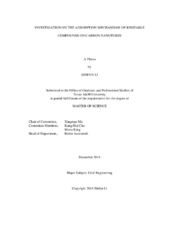| dc.description.abstract | This study investigates the adsorption of several ionizable compounds on different types of carbon nanotubes, including graphitized multi-walled carbon nanotubes (G-CNTs), carboxyl functionalized multi-walled carbon nanotubes (COOH-CNTs) and hydroxyl functionalized multi-walled carbon nanotubes (OH-CNTs). The ionizable compounds investigated in this study are benzoic acid (BA), 2-naphthoic acid (2-NA), 3-hydroxy-2-naphthoic acid (3-H-2-NA), 3-methoxy-2-naphthoic acid (3-M-2-NA) and 3-amino-2-naphthoic acid (3-A-2-NA).
Adsorption isotherms of BA on all three CNTs at pH 2 and pH 7 were measured and they are highly nonlinear. The maximum capacity of functionalized CNTs for BA was invariably higher than that of G-CNTs. The results agree with a previous report that benzoate displayed strong adsorption onto functionalized CNTs and is consistent with the assumption that the negative-charged H-bonds are formed during the adsorption. OH- stoichiometry confirmed that the adsorption of benzoate was accompanied with OH- release. In comparison, the adsorption of BA on G-CNTs at pH 2.0 is mostly attributed to the hydrophobic force. At pH 2, functionalized CNTs show a greater adsorption for BA than G-CNTs. The forming of hydrogen bonding between O-containing functional groups on CNTs and the oxygen on the carboxyl functional group on benzene rings was deemed as the main reason for the enhanced adsorption of functionalized CNTs.
The sorption isotherms of NA at pH 2.0 and 7.0 displayed a similar adsorption patterns as BA. Hydrophobic forces play significant roles in the adsorption of the acids
at pH 2.0. At pH 7.0, the adsorption of the base exhibited strong affinity to functionalized CNTs, suggesting that similar charge-assisted hydrogen bonding has been formed during adsorption. A comparison of hydroxide ion release from BA and NA adsorption on COOH-CNTs at pH 7.0 showed that the hydroxide release from NA almost overlaps with the hydroxide release for BA adsorption, suggesting that the molecular size doesn’t impact the forming of negative-charged H-bond. But the molecular structure did show a significant impact on the formation of this particularly strong intermolecular force. | en |


